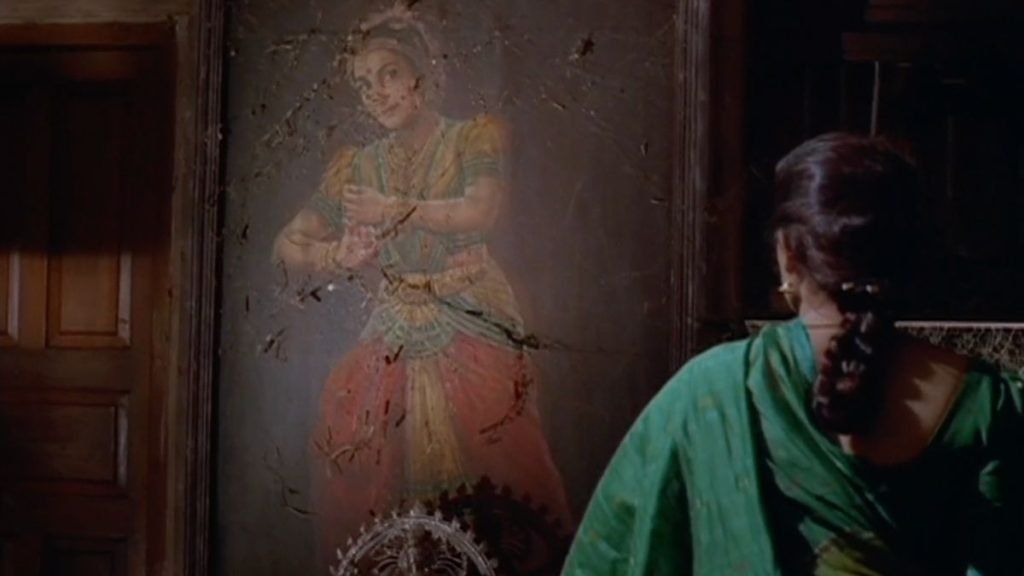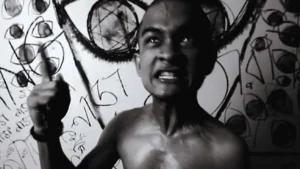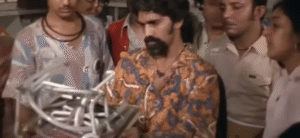If you’re a fan of Bollywood movies, then you must have heard of Bhool Bhulaiyaa (2007). Just as Vidya Balan’s character is enamoured by Manjulika, I, too, was in awe of this film that offered something new and exciting compared to its contemporaries.
Almost two decades later, I decided to dig deep into Manjulika’s legacy, and what I have found has really made me realise the character represents much more than just another movie “villain.”
What’s important to note is that Bhool Bhulaiyaa is a remake of Manichitrathazhu (1993), which was penned by Madhu Mattan… and he was inspired by a real crime committed in Kerala.
Table of Contents
The Murder That Allegedly Inspired Manichitrathazhu…
A few hundred years ago, when the Kingdom of Travancore existed, a gruesome murder spree was carried out in Alummoottil Tharavad (an ancestral home), located at Muttom. Central to this was the family that lived in the Alummoottil Meda…
Some Necessary Historical Context
The family that owned the Alummoottil Meda belonged to the Ezhavas community, which had historically been discriminated against because of the perception that they belonged to a low class and were, hence, categorised as untouchable.
According to a Madurai Kamaraj University report by researcher and scholar J. Jeba Shyni in July 2021, “The Ezhava community was considered to be a neglected Community and called untouchables. The Ezhavas are Hindus. Though they were Hindus, they were considered untouchables and even unapproachable(s).”
Their primary work was toddy tapping from coconut and palm trees back then. Moreover, they were denied the right to pray to upper caste dieties and faced heavy taxes, among other unjust social and political practices.

However, in the 19th Century, the community drafted a memorandum called the Malayali Memorial, which was then presented to the government, and it brought better changes for the community in the long run.
As per the same report, “The growth of the Ezhava Community was spectacular. The Community, which has been considered as Untouchables, had grown up to the level of dictating Kerala political affairs. The Ezhava Community excelled in developing the cultural activities of Kerala.”
With this backdrop, according to Onmanorama, “Alummoottil Meda was an Ezhava feudal landlord family in the kingdom of Travancore. Even though untouchability existed at that time, the Maharaja had conferred the title of ‘Channan’ to the family.”
In other words, despite the various negative social practices against their community, the family was quite high in terms of social hierarchy. According to the same outlet, the karanavar or the head of the family, was one of the few people who owned a car in the area — aside from the king himself.
The Family Drama That Led to the Killings
At the time, the matrilineal Marumakkathayam system of inheritance existed in Kerala.
However, according to various reports, a rumour had spread that the karanavar had willed the property and his riches against this tradition. (According to Mathrubhumi, he had willed it to his sons, and according to Onmanorama, he had willed it to his nieces and nephews instead of his own children… So there seems to be some clashing information here, and you should take this detail with a pinch of salt).
Either way, the begrudged party decided to take matters into their own hands and killed the head of the family while also stealing all the money and jewellery from the house.
Amid all this, one servant girl walked in on the scene and saw the gruesome crime being carried out — and so the eyewitness, too, was silenced forever.
In the end, residents of the Alummoottil Meda fled, and its status and prosperity vanished forever as well. Slowly but surely, legends of ghosts and hauntings became more associated with this property than its former glory.
The writer of Manichitrathazhu reportedly belonged to this family from his mother’s side and had grown up in the vicinity, hearing tales of this incident. These scary stories eventually served as the basis for what has become, arguably, the best Malayalam psychological thriller today.
Was Nagavalli/Manjulika a Real Person?
No, by all accounts, the dancer (known as Nagavalli in Manichitrathazhu and Manjulika in Bhool Bhulaiyaa) did not exist. She seems to be a figment of Mattan’s imagination.
Central to Manichitrathazhu and its Bollywood remake is the idea of feminine rage, and this adds a psychological feel to a film that may otherwise have had to rely solely on urban legends. As such, without the wronged court dancer, there wouldn’t be any “thriller” element in either film.
As for the painting of Nagavalli shown in Manichitrathazhu, the aforementioned article by Mathrubhumi states that the artist R Madhavan drew the portrait without a live model.
How Nagavalli Became Manjulika

As mentioned before, Bhool Bhulaiyaa is practically a shot-for-shot remake of Manichitrathazhu, a Malayalam film that was also remade in Kannada, Tamil, and Bengali in addition to Hindi.
So, Nagavalli’s story has become a pan-India legend at this point.
The first sequel, the Kannada Apthamitra (made in 2004), retained the same name for its lead female character. However, it was in the Tamil Chandramukhi (2005) that the “troubled” version of the female protagonist was renamed as Chandramukhi.

In the same year, this story was also turned into the Bengali film Rajmohol, in which Ganga becomes Deboshree, and Nagavalli is Chandramukhi.
Then came Bhool Bhulaiyaa, which was made in 2007. Shobhana’s Ganga/Nagavalli transformed into Balan’s Avni/Manjulika, and owing to Bollywood’s chokehold on the public, the latter is what struck most people’s memory.
In fact, while most in the South are aware that Manjulika’s story began as Nagavalli in the 1993 Manichitrathazhu, most people in India did not know about the character’s origins until much later. Some, probably, may not even know it now — but we hope this article finds them.
Bhool Bhulaiyaa’s Sequels
Manjulika’s feminine rage has been one of the central themes of all three films in the Bhool Bhulaiyaa horror franchise. However, the two sequels don’t do much to build on the myth/lore/character of Manjulika in conjunction with the first Bhool Bhulaiyaa.
In Bhool Bhulaiyaa 2, we see the introduction of twin sisters Manjulika and Anjulika, one of whom is good and one of whom becomes evil because her father incessantly compares her to her sister. Manjulika, as a child, develops much resentment for both her father and her goody-two-shoes sister, Anjulika, forming the plot of the film.
In Bhool Bhulaiyaa 3, the twin sister storyline is revived, but with the addition of another important character (don’t worry, no spoilers here) that completely changes the original conceptualisation of the scorned courtesan/dancer.
On paper, these theories sound like they could work, but frankly, only the execution of the first Bhool Bhulaiyaa is worth talking about — and that also, perhaps, because it practically copies everything already done in Manichitrathazhu. (Frankly, I think the first film works because it has masterfully copied the original; it continues to remain the best instalment in the Bollywood horror movie franchise).
Still, Manjulika is a fan-favourite character, one that has stuck with me ever since I first saw the 2007 film. She is probably one of the first times when the concept of feminine rage was explored so eloquently in (my limited knowledge) of cinema.
Hence, it deeply pained me to see that Manjulika’s arc was oversimplified and commercialised for the sake of mass consumption (and maybe profits).
Manichitrathazhu gives us this iconic character whose story could have gone a million different ways, but to see her end up as a weird ghostly apparition — in what can only be termed as lazy depictions — will hurt any fan of the character who is loved for her flawed nature.






